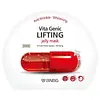What's inside
What's inside
 Key Ingredients
Key Ingredients

 Benefits
Benefits

 Concerns
Concerns

No concerns
 Ingredients Side-by-side
Ingredients Side-by-side

Aloe Barbadensis Leaf Juice
Skin ConditioningGlycerin
HumectantHamamelis Virginiana Water
AstringentVaccinium Myrtillus Fruit Extract
Skin ConditioningPhenoxyethanol
PreservativeSpirulina Platensis Extract
Skin ProtectingPassiflora Edulis Fruit Extract
Skin ConditioningAlcohol
AntimicrobialCarbomer
Emulsion StabilisingCocos Nucifera Oil
MaskingRicinus Communis Seed Oil
MaskingMelia Azadirachta Flower Extract
Skin ConditioningCoccinia Indica Fruit Extract
Skin ConditioningTetrasodium Glutamate Diacetate
Water
Skin ConditioningEuterpe Oleracea Fruit Extract
Sodium Benzoate
MaskingPotassium Sorbate
PreservativeAscorbic Acid
AntioxidantRetinyl Palmitate
Skin ConditioningGlycolic Acid
BufferingLactic Acid
BufferingCitric Acid
BufferingBeta Vulgaris Root Extract
Skin ConditioningAloe Barbadensis Leaf Juice, Glycerin, Hamamelis Virginiana Water, Vaccinium Myrtillus Fruit Extract, Phenoxyethanol, Spirulina Platensis Extract, Passiflora Edulis Fruit Extract, Alcohol, Carbomer, Cocos Nucifera Oil, Ricinus Communis Seed Oil, Melia Azadirachta Flower Extract, Coccinia Indica Fruit Extract, Tetrasodium Glutamate Diacetate, Water, Euterpe Oleracea Fruit Extract, Sodium Benzoate, Potassium Sorbate, Ascorbic Acid, Retinyl Palmitate, Glycolic Acid, Lactic Acid, Citric Acid, Beta Vulgaris Root Extract
Water
Skin ConditioningPanthenol
Skin ConditioningMethylpropanediol
SolventNiacinamide
SmoothingGlycerin
HumectantThiamine Hcl
MaskingRiboflavin
Cosmetic ColorantNiacin
SmoothingCarnitine Hcl
HumectantPantothenic Acid
Skin ConditioningBiotin
AntiseborrhoeicFolic Acid
Skin ConditioningAscorbic Acid
AntioxidantTocopherol
AntioxidantCyanocobalamin
Skin ConditioningGlyceryl Linoleate
EmollientGlyceryl Linolenate
EmollientGlyceryl Arachidonate
EmollientOpuntia Ficus-Indica Stem Extract
Skin ConditioningTrehalose
HumectantSodium Hyaluronate
HumectantAllantoin
Skin ConditioningAcrylates/C10-30 Alkyl Acrylate Crosspolymer
Emulsion StabilisingArginine
MaskingXanthan Gum
EmulsifyingAdenosine
Skin ConditioningDipotassium Glycyrrhizate
HumectantDisodium EDTA
1,2-Hexanediol
Skin ConditioningHydroxyacetophenone
AntioxidantWater, Panthenol, Methylpropanediol, Niacinamide, Glycerin, Thiamine Hcl, Riboflavin, Niacin, Carnitine Hcl, Pantothenic Acid, Biotin, Folic Acid, Ascorbic Acid, Tocopherol, Cyanocobalamin, Glyceryl Linoleate, Glyceryl Linolenate, Glyceryl Arachidonate, Opuntia Ficus-Indica Stem Extract, Trehalose, Sodium Hyaluronate, Allantoin, Acrylates/C10-30 Alkyl Acrylate Crosspolymer, Arginine, Xanthan Gum, Adenosine, Dipotassium Glycyrrhizate, Disodium EDTA, 1,2-Hexanediol, Hydroxyacetophenone
Ingredients Explained
These ingredients are found in both products.
Ingredients higher up in an ingredient list are typically present in a larger amount.
Ascorbic Acid is is pure Vitamin C. This form makes up the largest amount of vitamin C found naturally in our skin.
Not only is vitamin C great for your overall health and immune system, it also has plenty of benefits on your skin.
Vitamin C is best used for brightening skin. It improves dark spots, acne scars, and hyperpigmentation. This is because it blocks the process of skin darkening when exposed to UV.
Remember: Vitamin C should not replace sunscreen!
Your skin uses vitamin C to build collagen. Collagen is one key component in having a strong skin barrier and plump skin. Vitamin C also plays a role in regulating collagen, thus making it effective in improving wrinkles and fine lines.
Ascorbic acid shows potent antioxidant activity. As an antioxidant, it helps fight free-radicals. Free-radicals are molecules that may damage your skin cells. These antioxidants also protect skin against UV damage.
The best formulations include Vitamin E and/or ferulic acid. These two ingredients help stabilize and provide a boost in the benefits of ascorbic acid. This is because ascorbic acid becomes unstable when exposed to UV and air. In fact, you can tell your ascorbic acid has oxidized when it turns an orange-yellow color.
Ascorbic acid is generally compatible with other ingredients. However, using ascorbic acid with other active ingredients might cause irritation. Two ingredients: copper ions and benzoyl peroxide, will inactivate ascorbic acid completely.
Read more about other types of Vitamin C:
Foods rich with vitamin C include oranges, strawberries, broccoli, bell peppers, and more. When consuming Vitamin C, your skin receives a portion of the nutrients.
Learn more about Ascorbic AcidGlycerin is already naturally found in your skin. It helps moisturize and protect your skin.
A study from 2016 found glycerin to be more effective as a humectant than AHAs and hyaluronic acid.
As a humectant, it helps the skin stay hydrated by pulling moisture to your skin. The low molecular weight of glycerin allows it to pull moisture into the deeper layers of your skin.
Hydrated skin improves your skin barrier; Your skin barrier helps protect against irritants and bacteria.
Glycerin has also been found to have antimicrobial and antiviral properties. Due to these properties, glycerin is often used in wound and burn treatments.
In cosmetics, glycerin is usually derived from plants such as soybean or palm. However, it can also be sourced from animals, such as tallow or animal fat.
This ingredient is organic, colorless, odorless, and non-toxic.
Glycerin is the name for this ingredient in American English. British English uses Glycerol/Glycerine.
Learn more about GlycerinWater. It's the most common cosmetic ingredient of all. You'll usually see it at the top of ingredient lists, meaning that it makes up the largest part of the product.
So why is it so popular? Water most often acts as a solvent - this means that it helps dissolve other ingredients into the formulation.
You'll also recognize water as that liquid we all need to stay alive. If you see this, drink a glass of water. Stay hydrated!
Learn more about Water